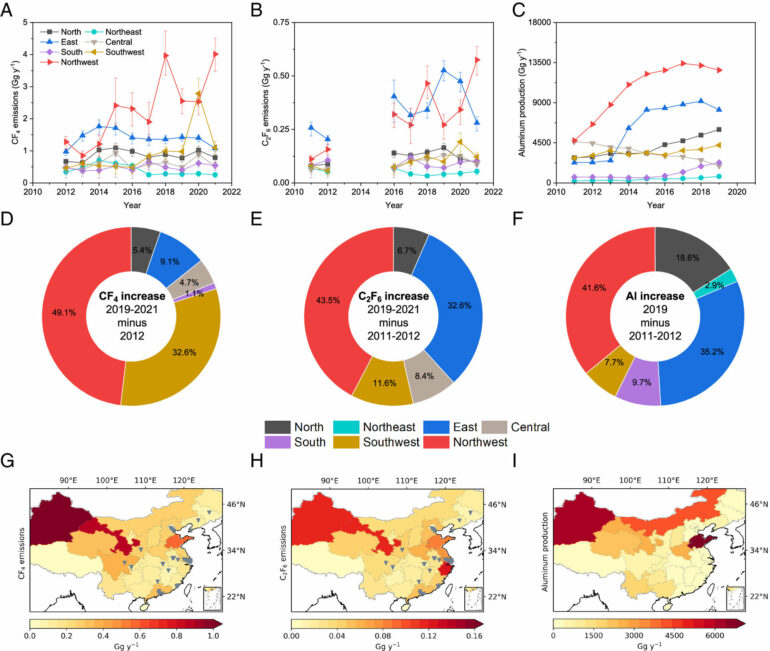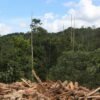When it comes to heating up the planet, not all greenhouse gases are created equal. They vary widely in their global warming potential (GWP), a measure of how much infrared thermal radiation a greenhouse gas would absorb over a given time frame once it enters the atmosphere.
For example, measured over a 100-year period, the GWP of methane is about 28 times that of carbon dioxide (CO2), and the GWPs of a class of greenhouse gases known as perfluorocarbons (PFCs) are thousands of times that of CO2. The lifespans in the atmosphere of different greenhouse gases also vary widely. Methane persists in the atmosphere for around 10 years; CO2 for over 100 years, and PFCs for up to tens of thousands of years.
Given the high GWPs and lifespans of PFCs, their emissions could pose a major roadblock to achieving the aspirational goal of the Paris Agreement on climate change—to limit the increase in global average surface temperature to 1.5 degrees Celsius above preindustrial levels.
Now, two new studies based on atmospheric observations inside China and high-resolution atmospheric models show a rapid rise in Chinese emissions over the last decade (2011 to 2020 or 2021) of three PFCs: tetrafluoromethane (PFC-14) and hexafluoroethane (PFC-116) and perfluorocyclobutane (PFC-318).
Both studies find that Chinese emissions have played a dominant role in driving up global emission levels for all three PFCs.
The Proceedings of the National Academy of Sciencesstudy identifies substantial PFC-14 and PFC-116 emission sources in the less-populated western regions of China from 2011 to 2021, likely due to the large amount of aluminum industry in these regions.
The semiconductor industry also contributes to some of the emissions detected in the more economically developed eastern regions. These emissions are byproducts from aluminum smelting, or occur during the use of the two PFCs in the production of semiconductors and flat panel displays. During the observation period, emissions of both gases in China rose by 78%, accounting for most of the increase in global emissions of these gases.
The Environmental Science & Technologystudy finds that during 2011-20, a 70% increase in Chinese PFC-318 emissions (contributing more than half of the global emissions increase of this gas)—originated primarily in eastern China.
The regions with high emissions of PFC-318 in China overlap with geographical areas densely populated with factories that produce polytetrafluoroethylene (PTFE, commonly used for nonstick cookware coatings), implying that PTFE factories are major sources of PFC-318 emissions in China. In these factories, PFC-318 is formed as a byproduct.
“Using atmospheric observations from multiple monitoring sites, we not only determined the magnitudes of PFC emissions, but also pinpointed the possible locations of their sources,” says Minde An, a postdoc at the MIT Center for Global Change Science (CGCS), and corresponding author of both studies.
“Identifying the actual source industries contributing to these PFC emissions, and understanding the reasons for these largely byproduct emissions, can provide guidance for developing region- or industry-specific mitigation strategies.”
“These three PFCs are largely produced as unwanted byproducts during the manufacture of otherwise widely used industrial products,” says MIT professor of atmospheric sciences Ronald Prinn, director of both the MIT Joint Program on the Science and Policy of Global Change and CGCS, and a co-author of both studies. “Phasing out emissions of PFCs as early as possible is highly beneficial for achieving global climate mitigation targets and is likely achievable by recycling programs and targeted technological improvements in these industries.”
Findings in both studies were obtained, in part, from atmospheric observations collected from nine stations within a Chinese network, including one station from the Advanced Global Atmospheric Gases Experiment (AGAGE) network. For comparison, global total emissions were determined from five globally distributed, relatively unpolluted “background” AGAGE stations, as reported in the latest United Nations Environment Program and World Meteorological Organization Ozone Assessment report.
More information:
Minde An et al, Substantial increase in perfluorocarbons CF4 (PFC-14) and C2F6 (PFC-116) emissions in China, Proceedings of the National Academy of Sciences (2024). DOI: 10.1073/pnas.2400168121
Yinuo Wang et al, Rising Perfluorocyclobutane (PFC-318, c-C4F8) Emissions in China from 2011 to 2020 Inferred from Atmospheric Observations, Environmental Science & Technology (2024). DOI: 10.1021/acs.est.3c10325
Provided by
Massachusetts Institute of Technology
This story is republished courtesy of MIT News (web.mit.edu/newsoffice/), a popular site that covers news about MIT research, innovation and teaching.
Citation:
Studies find China-based emissions of three potent climate-warming greenhouse gases have spiked in past decade (2024, July 18)



